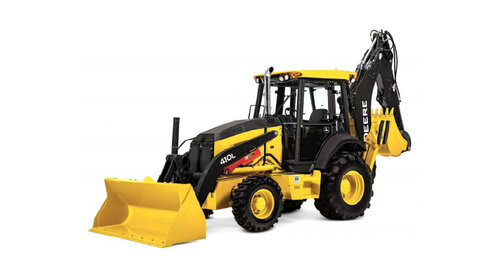The backhoe is such a versatile earthmoving machine, it’s often compared to a Swiss Army knife. It can’t open a can of beans or file your nails, but with a bucket on the back and a loader on the front, a backhoe is equally adept at excavating and moving materials. With a quick attachment switch, it also can sweep, plow, drill, grip or rip.
Learn more about the construction industry’s all-in-one tool and what it can do for you.
Features of a Backhoe
Let’s start at the back and work our way forward. The backhoe gets its name from the digging tool attached to the rear of the tractor. Think of it as an arm — the boom is the upper arm, the dipstick is the forearm and the bucket is the hand. It digs by dragging the bucket toward the machine.
In the middle is a tractor. It usually rolls on wheels, although some compact backhoes move on tracks. Behind the rear wheels are stabilizer legs that lower to the ground to keep the tractor steady while digging. In the cab atop the tractor, there are separate controls at the back and front to operate the digging arm and front loader. The driver’s seat rotates to face either direction.
On the front is a loader that raises and lowers to scoop, move and dump dirt or other materials.
What Is a Backhoe Used For?
One great advantage of a backhoe is its versatility. It can maneuver in tight spaces and tackle rough terrain or paved surfaces, which makes it useful for agriculture and landscaping in addition to construction. Farmers use backhoes to haul hay, till soil and build fences. Landscapers use backhoes to clear land, plant trees and dig ponds. On construction sites, they are used for smaller demolition projects, grading and material hauling, among many other jobs.
Depending on the task at hand, the bucket and loader can be replaced by other attachments, such as augers, rippers, compactors, hammers, snow blades and brooms. These gadgets allow the backhoe to drill, cut through hard surfaces, tamp down the earth, break rocks, plow snow and clear debris.
Backhoe Sizes
Backhoes come in different sizes, so it’s important to match the machine to the job. A compact backhoe could be the best choice for a job that only requires digging to a depth of eight feet, for small jobsites with tight spaces or for delicate ground that can’t support the extra weight of a full-size machine.
Bigger backhoes, with up to 150 horsepower, can dig to depths of 16 feet or so. If the job requires a deeper dig than that, an excavator may be a better choice — your local EquipmentShare branch will help you select the right machine for the job. Another factor to consider is the backhoe’s bucket size, which usually ranges from 12 to 36 inches, depending on the size of hole you need to dig and the weight of the materials you’ll be lifting.
Safety
Operating a backhoe doesn’t require a special license, but you should strongly consider some training through a technical school or on the job before you climb into the cab. Your state might require you to have a commercial driver’s license to use it on a public road. EquipmentShare’s T3 access control technology can be used to ensure only qualified users can operate your backhoe.
Like any piece of heavy equipment, a backhoe can be dangerous or cause damage to its surroundings. Never dig without first checking with local utility companies to ensure there aren’t wires or pipes beneath the dig site. Also, never dig without lowering the stabilizers. Be aware of your surroundings, including people, structures and overhead lines.
Rent a Backhoe For Your Next Project
Interested in renting a backhoe? EquipmentShare has 240+ branches nationwide with local experts who can help you find the right equipment for your job.

.svg)
.svg)














